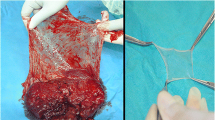Abstract
The amniotic membranes were collected from the placentae of selected and screened donors. Processing was done by washing the fresh amniotic membrane successively in sterile saline, 0.05% sodium hypochlorite solution and sterile distilled water until it was completely cleared of blood particles. The membranes were sterilized by gamma irradiation at 25 kGy. The processed amniotic membranes were applied to 50 open wounds comprising of 42 full thickness defects and eight partial thickness defects. These included leprotic, diabetic, traumatic, gravitational ulcers and superficial burn in the form of scald and corrosive burn. The radiation processed amniotic membranes favoured healing of unresponsive and non-healing ulcers of different etiologies. Ulcers with duration of minimum 3 weeks to maximum 12 months were found to heal in 2–6 weeks by the application of amniotic membranes.
Similar content being viewed by others
References
Atanassov W., Mazgalova J., Todorov R., Stereva K. and Trencheva W. (1994) Use of amniotic membranes as biological dressings in contemporary treatment of burns. Ann. Medit. Burns Club 7(4): 202–205.
Bari M.M. and Begum R. (2000) Use of radiation sterilized amniotic membrane grafts as temporary biological dressings for the treatment of leprotic ulcers. In: Phillips G.O., Strong D.M., von Versen R. and Nather A. (eds) Advances in Tissue Banking, Vol. 3, pp 477–483, World Scientific, Singapore.
Brown J.B., Fryer M.P., Randall P. and Lu M. (1953) Postmortem homografts as biological dressings for extensive burns and denuded areas. Ann. Surg. 138: 618–630.
Colocho G., Graham W.P. and Green A.E. (1974) Human amniotic membrane as a physiological wound dressing. Arch. Surg. 109: 370–373.
Kavarana N.M. (1998) The use of irradiated tissue grafts in surgical practices. In: Sood D.D., Reddy A.V.R., Iyer S.R.K., Gangadharan S. and Singh G. (eds) Applications of Radioisotopes and Radiation in Industrial Development, pp 549–554, NAARRI, Mumbai.
Lorusso R., Geraci V. and Masellis M. (1989) The treatment of superficial burns with biological and synthetic material: Frozen amnion and biobrane. Ann. Medit. Burns Club 2(2): 79–84.
Prabhasawat P. and Tesavibul N. (2001) Preserved amniotic membrane transplantation for conjunctival surface reconstruction. Cell Tissue Bank 2(1): 31–39.
Pruitt B.A. and Levine N.S. (1994) Characteristics and uses of biological dressings and skin substitutes. Arch. Surg. 119: 312–322.
Robson M.C., Samburg J.L. and Krizek T.J. (1973) Quantitative comparison of biological dressings. J. Surg. Res. 14: 431–434.
Sabella N. (1913) Use of fetal membranes in skin grafting. Med. Rec. NY 83: 478–480.
Sawney C.P. (1989) Amniotic membranes as a biological dressing in the management of burns. Burns 15: 339–342.
Thomson P.D. and Parks D.H. (1981) Monitoring banking and clinical use of amnion as a burn wound dressing. Arm. Pl. Surg. 7: 354–356.
Ward D.I. and Bennett J.P. (1984) The long term results of the use of human amnion in the treatment of leg ulcers. Br. J. Pl. Surg. 37: 191–193.
Author information
Authors and Affiliations
Corresponding author
Rights and permissions
About this article
Cite this article
Singh, R., Chouhan, U., Purohit, S. et al. Radiation Processed Amniotic Membranes in the Treatment of Non-Healing Ulcers of Different Etiologies. Cell Tissue Banking 5, 129–134 (2004). https://doi.org/10.1023/B:CATB.0000034077.05000.29
Issue Date:
DOI: https://doi.org/10.1023/B:CATB.0000034077.05000.29



